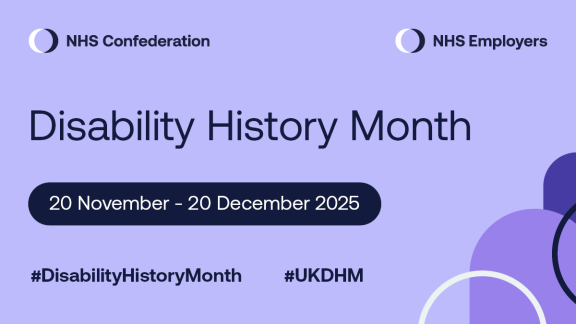Top tips for supporting the psychological safety of staff

Prioritising the psychological safety of staff and creating an environment where everyone feels included, safe to ask questions and able to work without fear of retribution or retaliation is essential. It creates a sense of belonging amongst colleagues, which leads to increased employee engagement, an improved culture, better wellbeing and mental health.
Organisations that foster this culture see an increase in productivity, improved policies and processes and overall success, as colleagues feel free to speak up and share their ideas. It is an essential part of the conscious retention of staff and was highlighted in the NHS Resolution - Being fair 2 report as a key factor in maintaining the workforce.
Watch our webinar on psychological safety at the bottom of this page, focusing on how to create a positive workplace culture in the NHS.
Top tips for creating a psychologically safe environment
1. Create an open and trusting environment
Build an open and trusting environment through meaningful interactions such as one to ones, chats over coffee, sessions and open forums for sharing ideas and opinions. Initiate open communication by asking colleagues how they feel, encourage sharing of both negative and positive experiences. This can be done in person, virtually or in a hybrid environment. The Harvard Business Review has some tips on how to do this.
2. Importance of language
Make sure everyone feels valued, this can be done by everyone, including leaders, openly saying sorry, thank you and asking for help. Initiate conversations with your colleagues in a respectful way, regardless of the situation, to get the best outcome for all parties involved. This article provides more information on embedding a healthy speaking up culture.
3. Tailor your actions to your organisation
You need to consider the specific needs of your organisation, rather than going for a one-size fits all response. Understand what your culture looks like and any specific barriers your staff face. This also applies on an interpersonal level, it is by understanding every person is different that you can create a psychologically safe environment.
4. Growth mindset
See mistakes as a learning opportunity, something to be openly shared and spoken about. Leaders should role model this by being open about their mistakes with their teams. An essential part of this is giving colleagues time to embed any key learning and use them to prepare in advance.
5. Demonstrate compassionate and inclusive leadership
Listen to your colleagues, show understanding and act with empathy towards their situation, and always provide help and support where you can. If you are open and demonstrate a growth mindset yourself, you can expect your employees to mirror this behaviour. Line managers could be upskilled to create Schwartz Rounds to support this. Michael West talks about the importance of compassionate leadership in his blog. Sign-up to NHS Confederation’s inclusive leadership pledge.
6. Tackle bullying and workplace harassment through education
Set clear expectations for respectful behaviour and encourage training and development on how to spot and tackle bullying, harassment and microaggressions in the workplace. Access resources and guidance to help build a positive culture and supportive environment to tackle bullying in healthcare.
Toxic behaviour costs the NHS over £2 billion a year, this infographic produced by the NHS Staff Council's Health, Safety and Wellbeing Partnership Group provides more information on statistics and key facts on the impact of bullying on workforce wellbeing.
7. Accountability
Whether you are a witness to micro-aggressions, experience verbal abuse or see something that just does not feel right, it is vital to speak up and challenge the behaviour, actions and raise awareness to drive the change and create a safe organisation.
The NHS has a Freedom to Speak Up policy that supports this and we have more information on raising concerns for employers and managers.
You can also get involved with Project S, a campaign to improve working conditions in the NHS, focusing on discrimination and workplace safety, and particularly the safety of women working in healthcare.
8. Allyship
Strong employee network groups can often provide safe spaces for diverse colleagues to find their voices and work together to drive change. Any form of allyship should focus on making other people feel comfortable and consider the different elements of power in an organisation. Recognise that how you look at a certain situation may be different from a diverse or a more junior colleague.
The NHS Staff Council’s Equality, Diversity and Inclusion Group has created a best practice guide to support joint partnership working with staff networks.
The NHS Confederation has three leadership networks that foster allyship, Health and Care Women Leaders Network, Health and Care LGBTQ+ Leaders Network and the BME Leadership Network.
9. Use the ABC model
Asking: What does it feel like? What does it sound like?
Benchmarking: Where are we now? Where do we want to go? What would it look like?
Considering: The elements of difference and power in an organisation. This could be reflecting job levels or diversity characteristics.
10. Policy
Designated workplace support on reporting bullying, harassment and whistleblowing. If you create an action plan really think about the impact of this, work with colleagues to ensure engagement and varied input and regularly review it, as this should be a live document and not just a tick-box exercise. NHS England No More Tick Boxes is a fantastic piece of research that demonstrate how to go about creating this.
11. Do this every day
Culture is not what is written in our policies, values, brand. It’s the everyday behaviours that happen in every corner of the workspace, from senior leadership down to all members of the support staff and reflected in how the medical staff treat each other and treat their patients.



